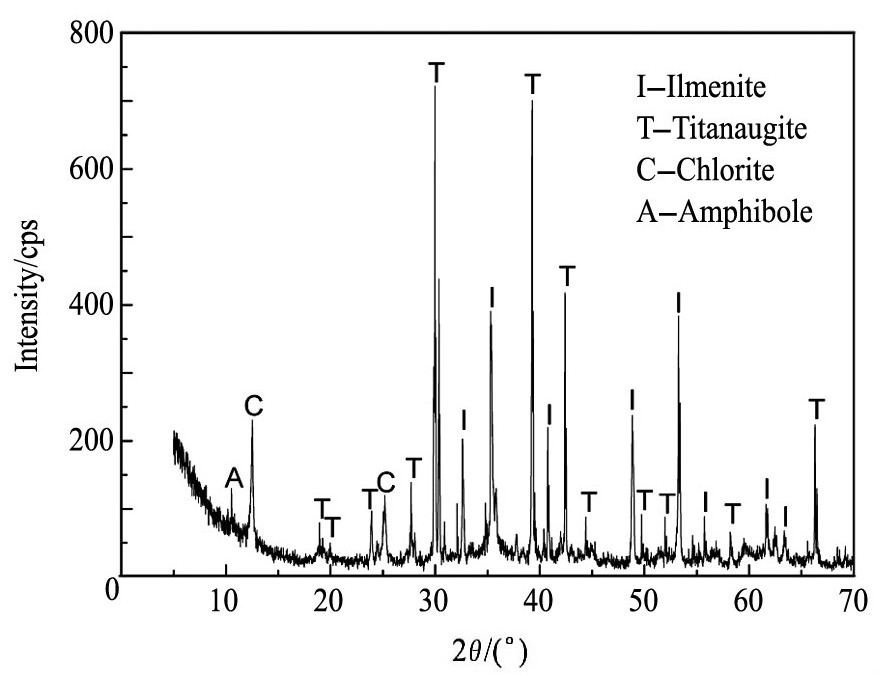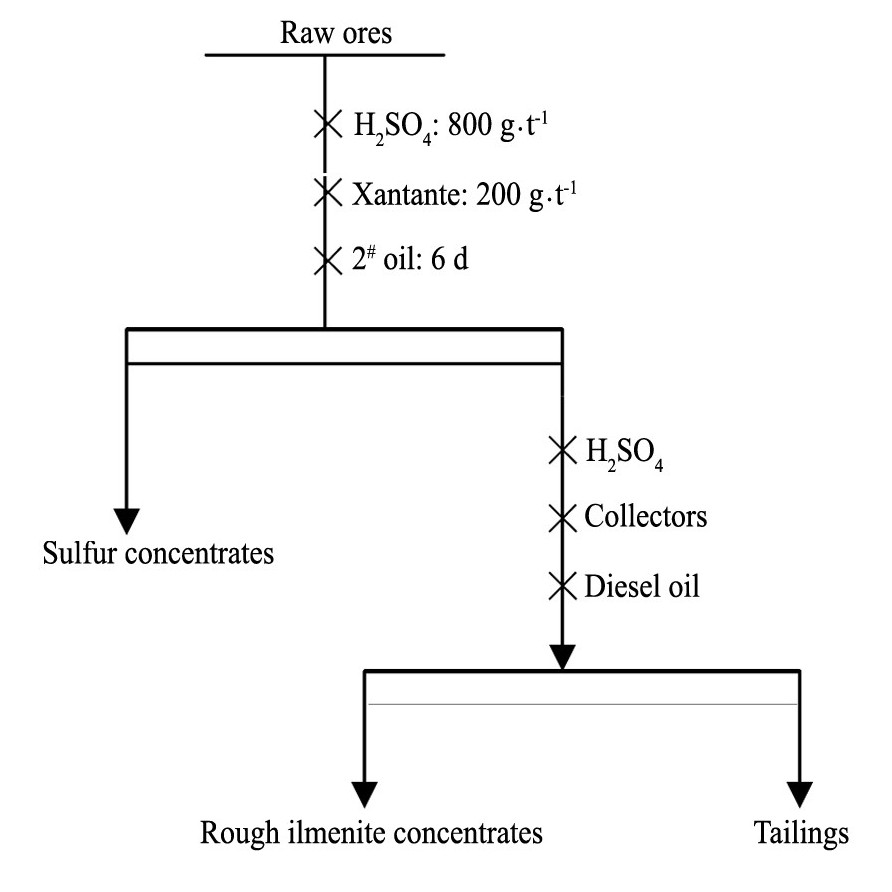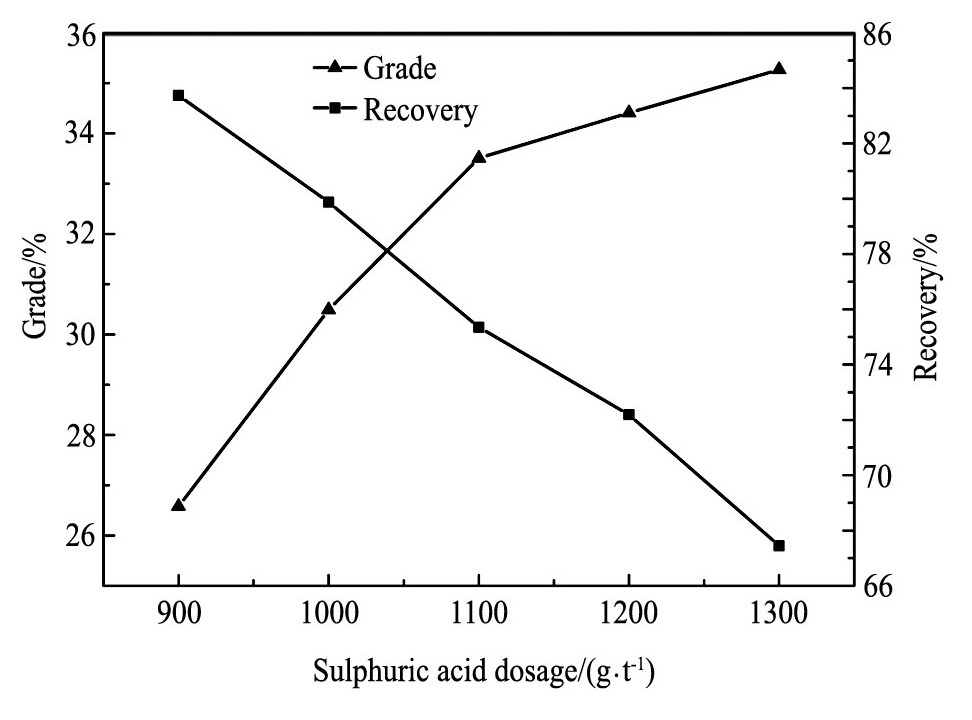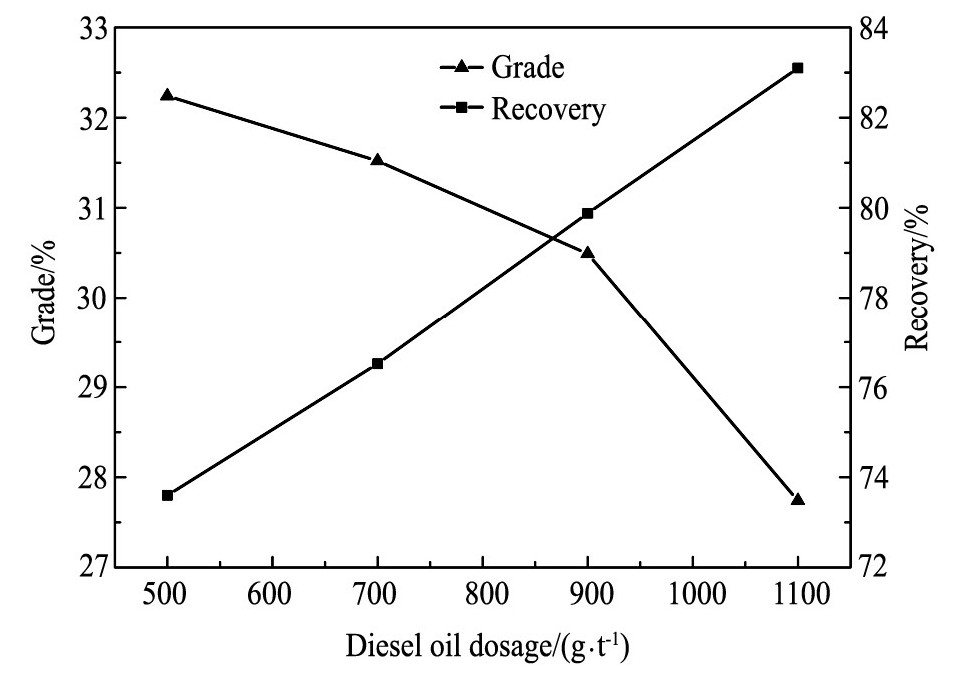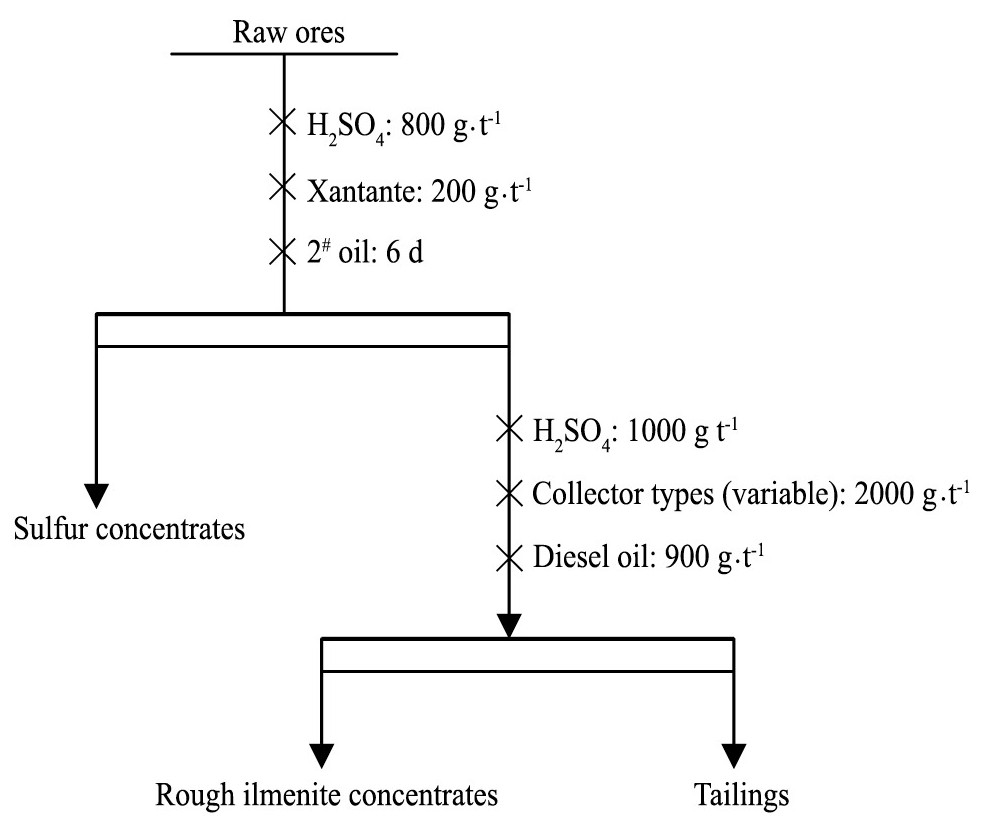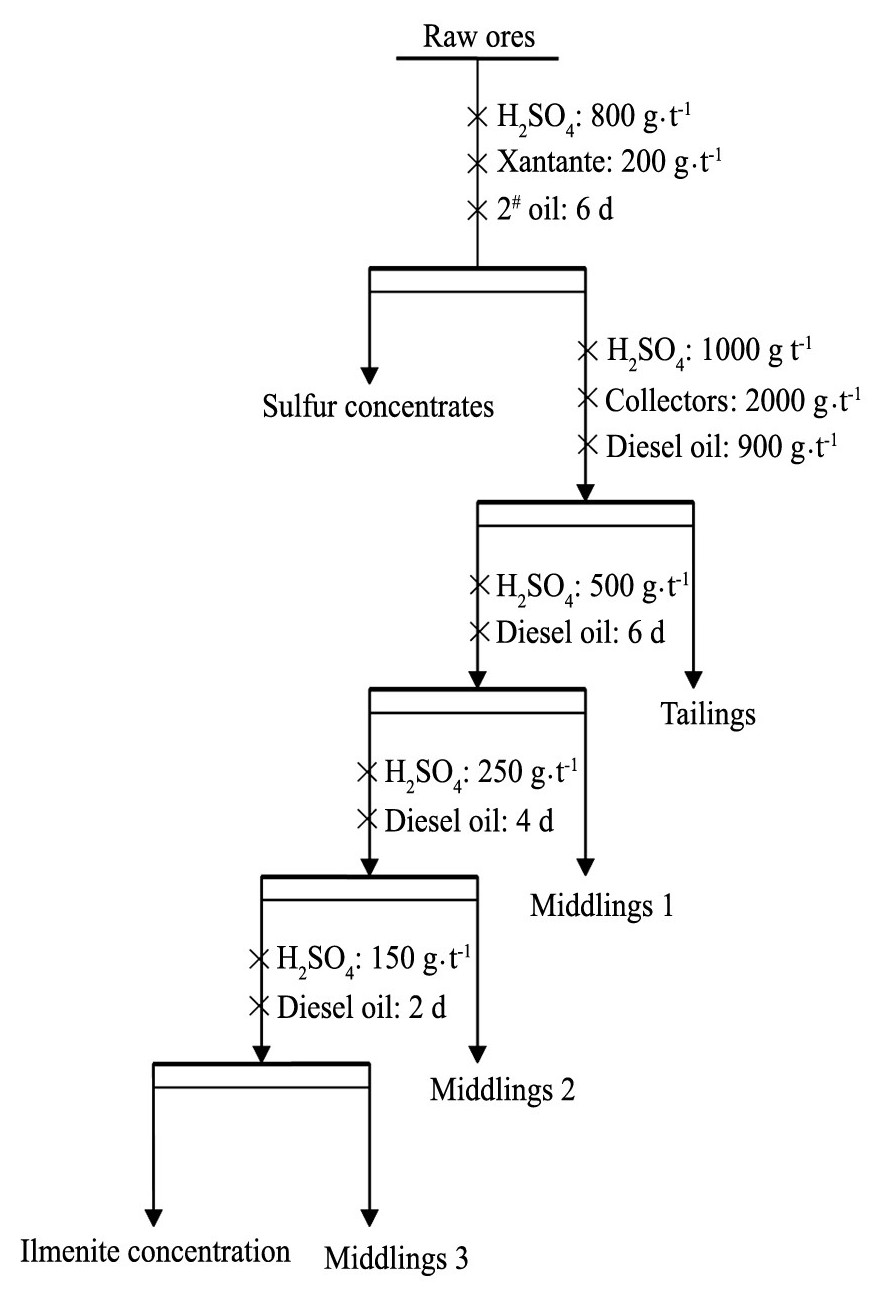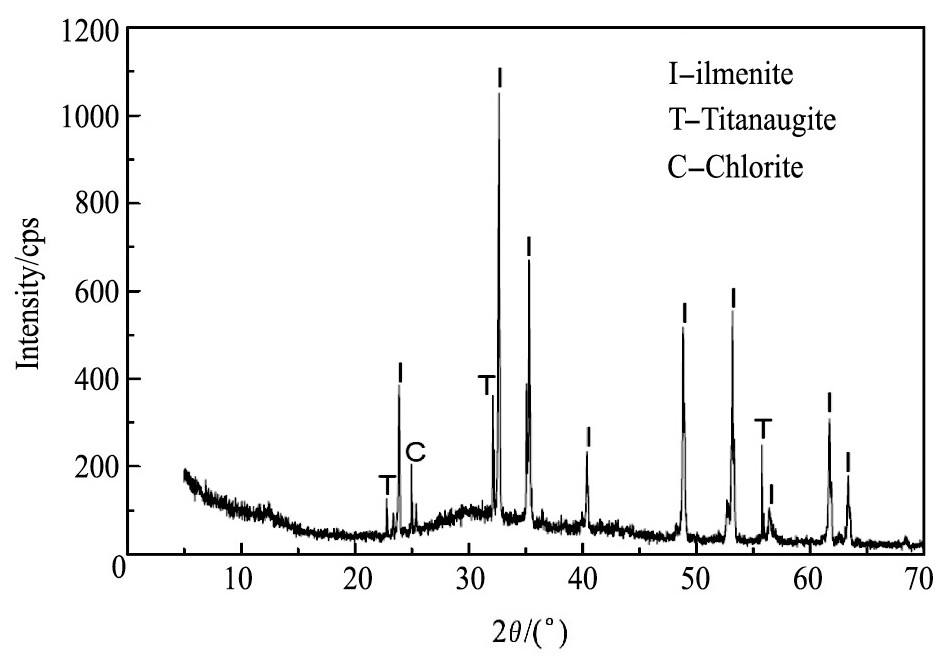网络首发时间: 2016-08-04 17:00
微细粒钛铁矿浮选捕收剂改性试验研究
中南大学资源加工与生物工程学院
攀钢集团矿业有限公司设计研究院
摘 要:
四川攀枝花存储着丰富的钒钛磁铁矿资源, 随着矿山进入中深部开采, 矿石性质发生了显著变化。原有捕收剂由于适应性较低, 在现场生产中普遍存在品位提升困难、回收率偏低等问题, 已经难以满足现场生产要求;因此新型钛铁矿捕收剂的研发对提升攀西地区钛铁矿资源的利用率具有重要的意义。在不改变现场原有生产条件的情况下进行了浮选试验条件的优化, 高效捕收剂的筛选, 通过不同比例含量的月桂酸、塔尔油和十二烷基苯磺酸钠对油酸钠的改性, 与现场原有药剂的粗选指标对比可知, 十二烷基苯磺酸钠所占比例为10%的组合捕收剂能有效提升钛铁矿粗选回收率。通过对某原矿含11.81%Ti O2的钛铁矿进行试验, 开路实验表明在精矿品位相近的情况下, 新型捕收剂可显著提升钛铁矿回收率10%以上。闭路试验表明, 采用预先脱硫-一粗三精一扫-中矿顺序返回的工艺流程, 采用现场原有药剂, 可以得到Ti O2品位为48.23%, 回收率为49.48%的钛铁矿精矿产品;新型捕收剂可以得到Ti O2品位为47.36%, 回收率为61.34%的合格精矿产品, 较现场原有药剂回收率提高了11.86%。这对新型钛铁矿浮选药剂的开发和应用具有借鉴作用。
关键词:
中图分类号: TD923.13;TD951
作者简介:陈攀 (1984-) , 男, 广西象州人, 博士, 讲师, 研究方向:矿物浮选、浮选药剂分子设计;E-mail:13739081721@163.com;;孙伟, 教授;电话:13507310692;E-mail:sunmenghu@126.com;
收稿日期:2016-06-22
基金:国家科技支撑计划项目 (2015BAB19B00);中南大学创新驱动计划项目 (2015CX005) 资助;
Experimental Study on Modification of Collector for Fine Grained Ilmenite
Chen Pan Zhai Jihua Wang Hongbin Sun Wei Lai Xiangsheng
School of Minerals Processing and Bioengineering, Central South University
Design and Research Institute of Panzhihua Iron and Steel Group Mining Co., Ltd.
Abstract:
Panzhihua, located in Sichuan Province, has abundant resources of vanadium titanium magnetite. As mines are exploited in deep mining, there are significant changes in the nature of ores. Due to the low adaptability of the original collectors, during the process of field production, there are problems such as the difficulty in promoting the grade and the low recovery. It has been difficult to meet the requirements of the field production. Therefore, it is of great significance to develop new collectors for the purpose of high recovery of ilmenite resources in Panzhihua district. In the case of not changing the original production conditions of the site, the optimum flotation test conditions and the screening of high efficient collectors were conducted. After comparison with the field agents of flotation recovery using collectors modified by laurel acid, tar oil and SDBS, it was found that the combined collectors with a 10% proportion of SDBS could work efficiently during the processing of ilmenite flotation. Experiments were conducted using ores containing11. 81% Ti O2 and the results of open circuit tests showed that combined collectors with a 10% proportion of SDBS could increase the flotation recovery by over 10% in the case of similar grade. The closed circuit tests were conducted adopting the technological process that pre-desulfurization, one roughing, three cleaning, one scavenging and the middlings returned in order. The closed circuit results showed that, using the field agents, the grade and recovery of concentrate products were 48. 23% and 49. 48%, respectively. At the same time, using SDBS modified collectors, the grade and recovery of concentrate products were 47. 36% and 61. 34%, respectively.The flotation recovery could be enhanced by 11. 86% and this could guide the new collectors development and application in the flotation field of refractory titanium ores.
Keyword:
ilmenite; combined collectors; high-recovery;
Received: 2016-06-22
钛元素素有工业维生素之称, 我国拥有的钛资源总量居世界首位[1], 然而易于开发利用的金红石的储量较少, 钛资源主要以钛铁矿的形式存在。由于其通常伴有铁、钒、钴、镍等多种有价金属元素, 并且随着资源的进一步开采, 泥化现象严重, 导致其开发利用难度很大、回收率较低[2,3]。特别是作为氧化矿, 钛铁矿选矿指标受温度影响变化较大, 冬天指标较差, 因此钛铁矿选矿高效捕收剂的研发和应用一直是选矿工作者的工作重点之一[4,5]。
目前, 钛铁矿常用的捕收剂主要为脂肪酸类、螯合捕收剂和新型组合捕收剂[6,7]。油酸钠改性组合捕收剂常用于氧化矿的浮选, 研究表明月桂酸钠和油酸钠组合使用可以增强药剂对白钨矿和萤石的捕收能力[8], 十二烷基苯磺酸钠和油酸钠混用可以使油酸的低温捕收能力和分散性得到增强[9], 塔尔油及乳化塔尔油也常单独用于钛铁矿的浮选[10], 然而通过月桂酸、塔尔油和十二烷基苯磺酸钠对油酸钠进行改性的组合捕收剂对钛铁矿浮选的研究鲜有报道。由于钛铁矿比重较大, 在钛铁矿的选别作业中也有重选方法, 此外还有电选、磁选和浮选, 目前应用最多的还是浮选法[11,12,13]。钛铁矿浮选捕收剂的研发和应用, 特别是对温度更具普适性的钛铁矿高效捕收剂的筛选和应用具有重大意义。
攀枝花是我国最大的钒钛磁铁矿生产基地, Ti O2储量占全国的91%以上[14,15], 长期以来, 攀枝花地区钛铁矿资源高效回收的难点之一是原矿中微细粒的矿物组分含量较高, 并且随着矿山进入中深部开采, 原有的浮选药剂难以适应原矿性质的变化, 导致浮选回收率大大下降, 造成钛资源的严重浪费[16,17,18]。为进一步提高钛铁矿的综合利用率, 增加企业效益, 减少资源浪费, 进行了原矿性质分析, 浮选条件实验的优化, 高效捕收剂的筛选, 进一步的开路和闭路试验均表明了十二烷基苯磺酸钠改性的组合捕收剂较现场所用药剂的优越性。
1试验
试验所用钛铁矿实际矿来自四川省攀枝花市, 矿样为攀枝花选铁尾矿, 经过弱磁除铁, 然后经两步强磁获得该浮选原矿, 对所来矿样进行化学多元素分析以及X射线衍射 (XRD) 测试, 结果如表1和图1所示。
由原矿样XRF和XRD测试结果可知, 原矿Ti O2品位为11.81%, 可以达到钛铁矿浮选的基本要求, 钛元素主要以钛铁矿形式存在, 其中主要的脉石矿物为钛辉石、绿泥石和闪石等硅酸盐类矿物。
对原矿进行筛分分析, 结果如表2所示。
由表2可知, 原矿有价金属累计分布率在+0.038 mm以上占比57.78%, 这部分属于较易浮选的部分, 也是目前最终精矿的主要来源。但从表2中可知, 粒级在-0.038 mm的微细颗粒产率为34.25%, 金属分布率所占比例为42.44%, 该部分综合品位高达14.58%, 因此强化针对微细粒级的回收将是有效提升精矿产品回收率的关键。
表1 矿样化学多元素分析结果Table 1 Results of chemical elements analysis of raw ores (%, mass fraction) 下载原图

表1 矿样化学多元素分析结果Table 1 Results of chemical elements analysis of raw ores (%, mass fraction)
图1 原矿样XRD测试结果Fig.1 XRD result of raw ores
表2 原矿样粒级分布率及金属累计分布率Table 2 Sample size distribution rate and cumulative dis-tribution rate of metal (%) 下载原图
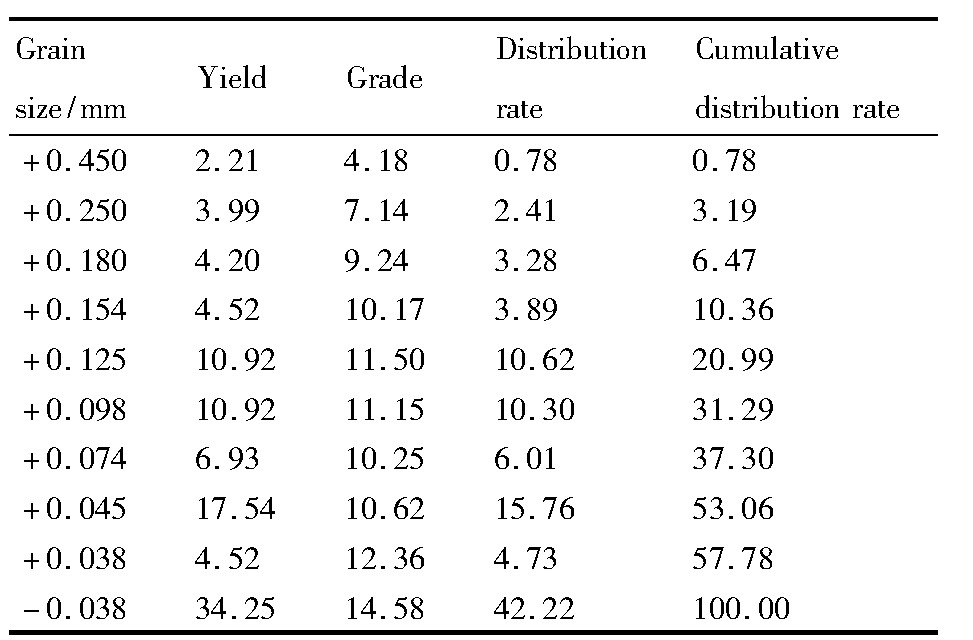
表2 原矿样粒级分布率及金属累计分布率Table 2 Sample size distribution rate and cumulative dis-tribution rate of metal (%)
2结果与讨论
2.1浮选条件实验的优化
针对给矿, 进行浮选试验条件的优化是非常有必要的, 针对钛粗选硫酸用量、捕收剂用量、辅助捕收剂柴油的用量, 进行了条件实验, 试验原则流程如图2所示。
硫酸常用做钛铁矿浮选p H调整剂[19], 主要是由于硫酸可以在钛铁矿表面发生特性吸附, 活化钛铁矿表面, 因此硫酸的用量对于钛铁矿浮选指标至关重要。试验考察了硫酸用量对钛铁矿给矿浮选指标的影响, 试验结果如图3所示。
由图3可知, 随着硫酸用量的增加, 钛铁矿粗选精矿回收率减小, 而Ti O2品位逐级增加。当硫酸用量为900 g·t-1时, 粗选钛精矿产率为36.62%, 品位26.58%, 回收率83.74%, 此时硫酸用量较小, 硫酸对钛铁矿活化浮选现象不明显, 不能得到较高品位的钛粗精矿。当硫酸用量进一步增加, 钛铁矿粗选钛精矿品位可以提升至35.27%, 此时硫酸用量为1300 g·t-1, 与此同时, 钛粗精矿的产率和回收率分别下降至22.54%和67.45%, 钛资源不能得到有效回收。为得到合适的品位和回收率, 以期实现钛铁矿的综合利用, 综合考虑确定硫酸用量为1000 g·t-1, 此时钛粗精矿产率为31.15%, Ti O2品位30.49%, 回收率为79.88%。
图2 优化浮选实验条件原则流程图Fig.2 Principle flow chart for optimal flotation conditions
图3 硫酸用量对钛铁矿粗选回收指标的影响Fig.3Effect of sulphuric acid dosage onflotation index of il-menite roughing
确定硫酸最佳用量为1000 g·t-1之后, 进行了捕收剂用量条件实验, 由于捕收剂是浮选过程中最主要的药剂, 其用量与精矿品位和回收率密切相关, 因此, 开展了捕收剂用量的试验研究, 结果如图4所示。
由图4可知, 随着捕收剂用量的增加, 粗选精矿回收率增加而此时Ti O2品位却有所下降。当捕收剂用量从1600 g·t-1增加到2400 g·t-1, 粗选钛精矿Ti O2回收率从72.77%增加至85.37%, 回收率增加10%以上, 而此时由于捕收剂的用量增加, 脉石矿物夹带现象严重, 导致粗选钛精矿Ti O2品位由33.46%降低至26.27%, 不利于后续的精选作业。综合考虑回收率和品位确定最终捕收剂用量为2000 g·t-1, 此时, 钛铁矿粗选产率31.26%, Ti O2品位为30.52%, 回收率为80.16%。
图4 捕收剂用量对钛铁矿粗选回收指标的影响Fig.4 Effect of collector dosage onflotation index of ilmenite roughing
在钛铁矿的浮选过程中, 为了高效回收有价金属, 通常加入辅助捕收剂[20]。考察了辅助捕收剂煤油用量对钛铁矿回收指标的影响, 实验结果如图5所示。
从图5可知, 辅助捕收剂柴油用量的增加可以提高精矿回收率, 但会影响精矿产品的品位。当煤油用量由500 g·t-1增加至1100 g·t-1时, 钛铁矿粗选钛精矿产率可由26.94%增加至34.51%, 回收率也从73.60%增加至83.10%, 此时品位则由32.24%下降至27.74%, 综合考虑浮选指标, 选择柴油用量为900 g·t-1。
2.2捕收剂的筛选试验
众所周知, 浮选过程主要是在各种药剂的共同作用下完成的, 其中捕收剂是决定目的矿物可浮性的决定性因素。在不改变现场磨矿细度的条件下, 针对选厂原有皂类捕收剂选矿回收率偏低的情况, 对选矿捕收剂进行了初步筛选试验。考虑到矿石中含有部分硫化矿, 因此在氧化矿浮选前进行了预先脱硫试验, 具体流程图如图6所示。
实验过程中, 变量为捕收剂种类, 试验选择了以下几种捕收剂种类:10%砷酸+月桂酸/塔尔油/十二烷基苯磺酸钠 (含量10%或者15%) +皂类捕收剂。实验结果如下表3~5所示。
由于粗选主要考虑产品的回收率, 为清楚对比各类捕收剂对钛铁矿选矿指标的影响, 将回收率与各类捕收剂做以下柱状图。
图5 柴油用量对粗选浮选指标的影响Fig.5 Effect of diesel oil dosage on flotation index of ilmenite roughing
图6 捕收剂筛选原则流程图Fig.6 Principle flow chart for collector screening
表3 月桂酸用量对钛铁矿粗选浮选指标的影响Table 3 Effect of laurel acid dosage on flotation index of ilmenite roughing (%) 下载原图
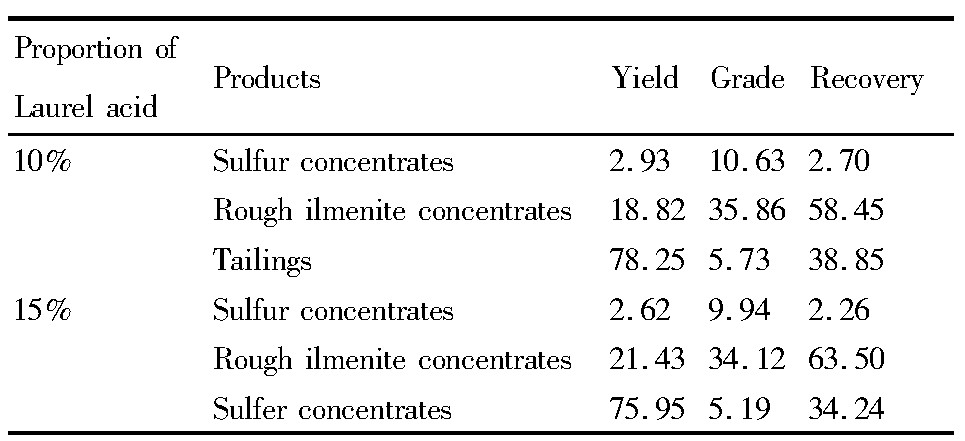
表3 月桂酸用量对钛铁矿粗选浮选指标的影响Table 3 Effect of laurel acid dosage on flotation index of ilmenite roughing (%)
表4 塔尔油用量对钛铁矿粗选浮选指标的影响Table 4 Effect of tar oil dosage on flotation index of ilmen-ite roughing (%) 下载原图
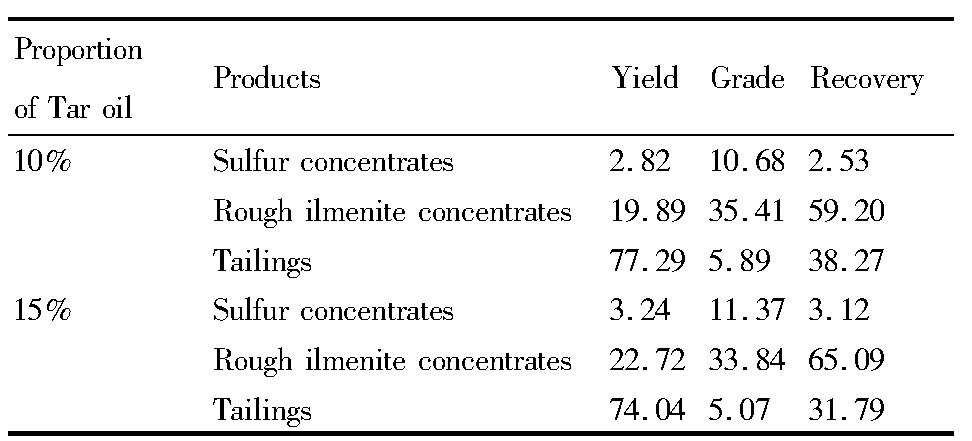
表4 塔尔油用量对钛铁矿粗选浮选指标的影响Table 4 Effect of tar oil dosage on flotation index of ilmen-ite roughing (%)
从表3到表5和柱状图7可知:随着月桂酸和塔尔油在组合捕收剂中所占的比例逐渐增加, 钛铁矿的浮选回收率也相应的有所增加, 这主要是增加了捕收剂的起泡能力, 从而使矿物颗粒与气泡碰撞概率大大增强, 进而改善浮选效果;虽然月桂酸和塔尔油的添加对钛铁矿的总回收率有一定程度的提升, 但仍低于现场药剂。在捕收剂的筛选试验中, 发现十二烷基苯磺酸钠所占比例为10%的组合捕收剂即可高效的回收矿样中的钛铁矿, 浮选指标较现场药剂更好, 因此十二烷基苯磺酸钠所占比例为10%的组合捕收剂是钛铁矿高效浮选捕收剂的优良选择。
表5 十二烷基苯磺酸钠用量和现场药剂对钛铁矿粗选浮选指标的影响Table 5Effect of sodium dodecyl benzene sulfonate (SD-BS) and field agent dosage on flotation index of ilmenite roughing (%) 下载原图

表5 十二烷基苯磺酸钠用量和现场药剂对钛铁矿粗选浮选指标的影响Table 5Effect of sodium dodecyl benzene sulfonate (SD-BS) and field agent dosage on flotation index of ilmenite roughing (%)
图7 捕收剂种类对钛铁矿粗选回收率的影响Fig.7 Effect of collector types onflotation index of ilmenite roughing
A:Proportion of laurel acid being 10%;B:Proportion of laurel acid being 15%;C:Proportion of tar oil being 10%;D:Proportion of tar oil being 15%;E:Proportion of SDBS being10%;F:Field agents
2.3十二烷基苯磺酸钠改性捕收剂和现场药剂开路对比试验
从2.2的研究可以发现, 十二烷基苯磺酸钠所占比例为10%的组合捕收剂在粗选的情况下是优于现场使用的皂类捕收剂和其他4种组合捕收剂。由于浮选过程主要是矿粒和药剂的相互作用, 并且在精选的过程中为了提高品位一般不加或者加入少量捕收剂以辅助目的矿物的浮选, 因此除了粗选以外, 还应值得重点考虑的因素是矿物与捕收剂之间接触的强度, 若矿物与捕收剂之间的接触强度较弱, 则不足以在后续的精选作业中使精矿进一步富集在精矿产品中, 导致目的矿物脱落在中矿产品中, 不利于目的矿物的回收。在钛铁矿的选别试验中, 这同样是值得考虑的问题, 因此进行了十二烷基苯磺酸钠所占比例为10%的组合捕收剂和现场皂类捕收剂的开路对比试验, 以考察粗选所筛选出的组合捕收剂是否适用于钛铁矿的整个浮选工艺。试验流程和药剂制度如图8所示。
根据以上所示的开路流程图进行的开路实验结果如表6和7所示。
从开路的实验结果不难看出, 相比现场药剂而言, 采用十二烷基苯磺酸钠所占比例为10%的组合捕收剂在同样的药剂制度和浮选流程条件下对钛铁矿的捕收性能更强, 这充分说明十二烷基苯磺酸钠改性的组合捕收剂可以更加牢固地和钛铁矿作用, 在精矿品位变化不大的情况下, 可以使选矿回收率提高10%以上, 这充分表明了十二烷基苯磺酸钠所占比例为10%的组合捕收剂可以实现对钛铁矿的高效回收利用。
图8 开路实验流程图Fig.8 Flow chart of open circuit experiments
表6 十二烷基苯磺酸钠改性捕收剂开路流程实验结果Table 6 Flotation results of open circuit experiments using SDBS modified collectors (%) 下载原图

表6 十二烷基苯磺酸钠改性捕收剂开路流程实验结果Table 6 Flotation results of open circuit experiments using SDBS modified collectors (%)
表7 现场药剂开路流程实验结果Table 7 Flotation results of open circuit experiments using field agents (%) 下载原图
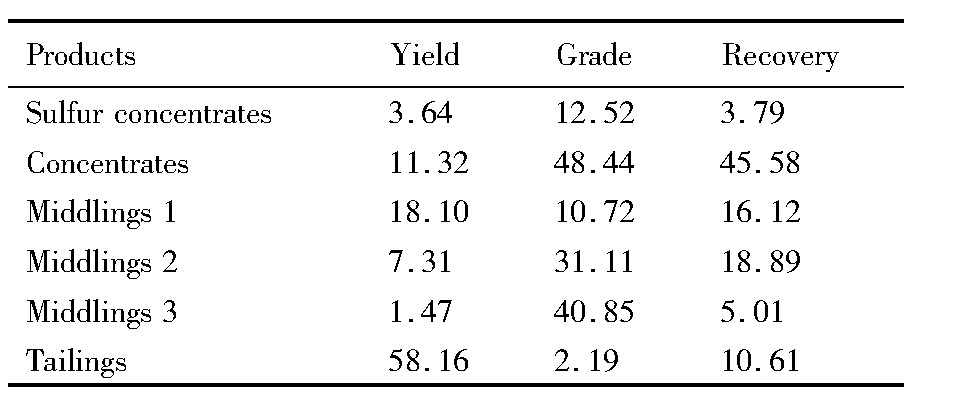
表7 现场药剂开路流程实验结果Table 7 Flotation results of open circuit experiments using field agents (%)
2.4十二烷基苯磺酸钠改性捕收剂和现场药剂闭路试验
通过以上的研究不难发现, 十二烷基苯磺酸钠占比10%的组合捕收剂是浮选钛铁矿的优良捕收剂, 因此进行了闭路试验。闭路是在开路的基础上, 采用中矿顺序返回的闭路流程, 闭路试验结果如表8所示。
由表8和9可以看出, 采用预先脱硫-一粗三精一扫-中矿顺序返回的工艺, 使用现场所用捕收剂进行闭路可以得到产率为12.35%合格钛铁矿精矿产品, 精矿中Ti O2品位为48.23%, 回收率为49.48%;同时, 使用十二烷基苯磺酸钠改性的捕收剂进行闭路可以得到产率为15.59%, Ti O2品位为47.36%, 回收率为61.34%的合格钛精矿。比较可知, 在精矿品位相近的情况下, 十二烷基苯磺酸钠改性的捕收剂可以大幅度提高钛铁矿的回收率。为分析十二烷基苯磺酸钠改性的捕收剂可以大幅度提高钛铁矿回收率的原因, 对闭路所得精矿产品进行了粒级回收率的计算, 考虑到强化微细粒级浮选是提高最终浮选回收率的关键, 在粒级回收率计算过程中将产品分为+0.038和-0.038 mm两个粒级, 计算结果如表10所示。由表10可知, 相比现场药剂, 十二烷基苯磺酸钠改性的捕收剂可以显著提高两个粒级的回收率, 其中+0.038 mm粒级回收率增加了9.47%, -0.038 mm粒级回收率增加了15.64%, 由此可见, 十二烷基苯磺酸钠改性的组合捕收剂在强化易浮粒级回收的同时又对微细粒级的钛铁矿的回收具有巨大促进作用, 这是最终精矿产品回收率提高的关键。这主要是由于十二烷基苯磺酸钠改性捕收剂较现场使用药剂而言, 可以产生更加均匀, 粒径较小的泡沫, 并且泡沫量较为丰富, 这对于微细粒级的钛铁矿的捕收是极为有利的。因此, 采用十二烷基苯磺酸钠所占比例为10%的组合捕收剂可以有效地回收利用该尾矿中富含的钛铁矿资源。
表8 现场捕收剂闭路试验结果Table 8 Results of closed-circuit test using field agents (%) 下载原图

表8 现场捕收剂闭路试验结果Table 8 Results of closed-circuit test using field agents (%)
表9 十二烷基苯磺酸钠改性捕收剂闭路试验结果Table 9 Results of closed-circuit test using SDBS modified collectors (%) 下载原图

表9 十二烷基苯磺酸钠改性捕收剂闭路试验结果Table 9 Results of closed-circuit test using SDBS modified collectors (%)
为了进一步分析钛铁矿精矿产品中的主要杂质成分, 取十二烷基苯磺酸钠改性捕收剂浮选钛铁矿精矿产品进行XRD分析, 结果如图9所示。
精矿产品XRD分析结果表明, 精矿产品中主要存在的物相为钛铁矿, 表明钛铁矿已经得到了充分的富集, 其中还含有少量的钛辉石和绿泥石物相, 这说明精矿产品中主要的杂质还是少量的硅酸盐类脉石, 这是影响最终精矿产品品位的主要因素。
表1 0 闭路精矿产品粒级回收率计算结果Table 10 Calculation results of grain size recovery of closed-circuit concentrates (%) 下载原图

表1 0 闭路精矿产品粒级回收率计算结果Table 10 Calculation results of grain size recovery of closed-circuit concentrates (%)
图9 闭路流程精矿产品XRD分析结果Fig.9 XRD result of closed-circuit concentrates
3结论
1.在最佳条件实验下, 通过捕收剂种类的筛选, 得出在粗选的条件下, 相比于现场使用的皂类捕收剂和月桂酸/塔尔油组合捕收剂, 十二烷基苯磺酸钠所占比例为10%的组合捕收剂对钛铁矿的捕收能力更强, 更加适合于钛铁矿的浮选试验。
2.开路实验表明, 在不改变选厂磨矿细度的条件下, 按照现场原有的选矿生产流程和药剂制度, 只改变捕收剂种类的情况下, 十二烷基苯磺酸钠所占比例为10%的组合捕收剂可以在保证精矿品位的前提下, 提高产品回收率10%以上。
3.闭路试验结果表明:采用预先脱硫-一粗三精一扫-中矿顺序返回的工艺, 使用十二烷基苯磺酸钠所占比例为10%的捕收剂可获得品位47.36%, 回收率61.34%的钛铁矿精矿产品, 相对于现场药剂, 在精矿品位相近的情况下, 回收率可以提高11.86%。
参考文献


